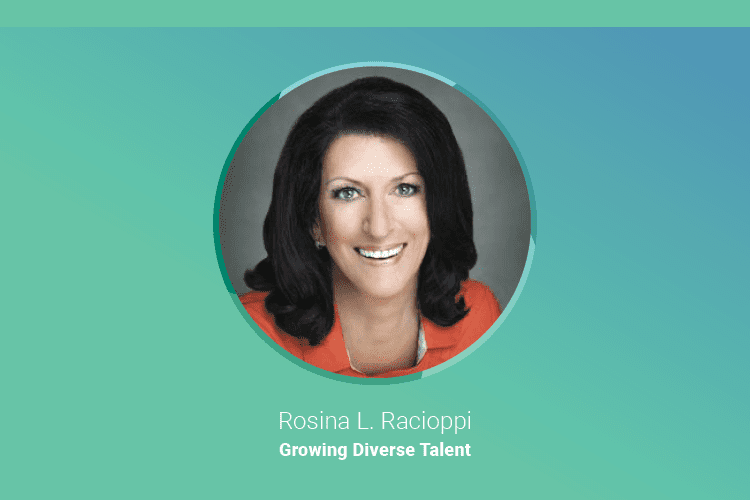
Q: The pandemic has greatly impacted women in the workplace, putting increased pressure on talent managers to help women overcome new challenges. As these discussions continue, how can we use this moment in history as an opportunity to educate ourselves and implement strategies to do better in the future? And how do we ensure our people thrive during this time?
A: Offer opportunities
Prior to the pandemic, companies were focused on creating parity in their organization, not necessarily because it was a nice thing to do, but because of the key business objectives associated: most notably the proven statistic that diverse teams yield higher business results.
That said, HR leaders have the unique opportunity to advocate for more than just the fundamental basic needs of women in their workplace; they can also give women opportunities for personal and professional development. Use the challenges your business is facing to shape their leadership development opportunities, whether through a new project or a new role entirely, through mentorship and management.
The WOMEN Unlimited’s 2021 Impact Report found women’s workplace performance actually improved over the course of the pandemic when women were offered leadership and growth opportunities by managers and mentors. While this shouldn’t be a shock, it is often overlooked by talent and HR managers. As we continue to shift and adapt to new ways of working, those statistics should be top of mind.
Promote intentional learning
In the summer of 2020, a McKinsey article detailed the importance of honing learning and leadership through practice. When there’s a framework for development within a safe environment where people feel supported as they learn and stretch the boundaries of their competencies, the practice of learning and skill-building becomes sustainable. And as a result, the organization becomes a part of each person’s growth and development.
In a time of uncertainty, we need to create agile leaders. When living in this ambiguous state, we consistently find ourselves in a place where we need leaders who can grow into roles and make decisions around complicated changes and processes. We need to use this period of time to help women build and stretch those leadership muscles.
Implement sustainable strategies
How are you helping your leaders create strategies for their work? Now more than ever, it is crucial HR leaders ensure there are strategies for visibility for women, their accomplishments and how they fit into corporate objectives – especially as the way we work is constantly shifting.
I’m not a big believer in an either/or strategy for work and believe that there are jobs that can be completely remote. If there’s a decision made by management, team leaders and the employee herself that her role can be fully remote, there then needs to be a strategy for visibility because it’s easy to feel lost and forgotten when working remotely. The same applies to hybrid roles; what is the rhythm that will make each individual feel as though their work, input and accomplishments matter and feel like what they do for the organization provides value and is appreciated?
According to a survey conducted as part of the Impact Report, almost 60 percent of women reported experiencing new obstacles due to the shift to remote work. But it wasn’t just work-related challenges that tripped them up; challenges related to childcare, schooling and other personal concerns exacerbated by COVID-19 all impacted their ability to do meaningful work. The solution, according to participants, is sustainable strategies implemented by management to ensure everyone has the tools needed to do their best work.
Create mentorship opportunities
The best leaders are the best learners, as they say, and the ability of mentors to nurture and coach an organization’s talent is crucial now when it’s so difficult to find and retain employees. As basic as it sounds, employees want to feel they’re being not only valued, but also supported and nurtured as they grow into their role. By pairing senior mentors with more junior mentees, HR leaders can ensure employees at every level receive the institutional support they need to navigate the challenges both inside and outside of work that impact them every day.
In another survey conducted as part of our Impact Report, we found almost 100 percent of women utilized their mentor to leverage their career development, and more than 30 percent of those women discussed work and personal challenges as part of mentorship programs. The numbers don’t lie – mentorship is essential to employee growth and leadership.
If there’s one thing we’ve learned from the pandemic, it’s that relationships help you navigate uncertain times quickly and effectively. Talent leaders must continue to create frameworks to help women understand the importance of building and maintaining these relationships in hybrid or remote work environments the same way they did in-person. After all, the people are the same. It’s just the medium that’s different.
Strategies for visibility, inclusion and leadership opportunities are where this conversation starts and ends. While it’s important to discuss the way we work and how it has changed since early 2020, it’s equally important to understand that the work isn’t just the outcome someone produces. It’s the person who is doing the work, their organizational understanding, their leadership skills and the opportunities they have to understand the shifting workplace priorities that so often accompany this period of rapid change.












